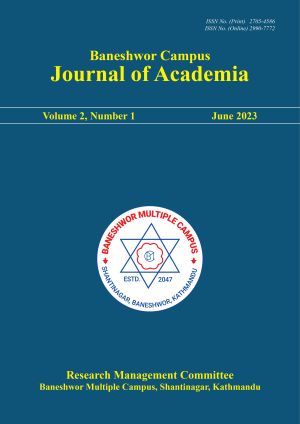Humans and Animals’ Relationship in Karen Joy Fowler’s We Are All Completely Beside Ourselves
DOI:
https://doi.org/10.3126/bcja.v2i1.55760Keywords:
Human, animal, ecopoetics, species, nature, cultureAbstract
This article has explored on the relationships between humans and nonhuman creatures which has long been a predominant dichotomous conceptualization. Especially it has analyzed Karen Joy Fowler’s book We Are All Completely Beside Ourselves which focuses on the relationship between humans and animals. The book also makes readers think about the interspecies relationship’s ethics and epistemologies as a part of ecopoetics. The present debate over animal rights and the condemnation of speciesism, which accords human creatures’ epistemic and ontological privilege, are central issues in critical and cultural animal studies.
The dichotomous view of human-animal relationships holds that there is a categorical border between humans - who are perceived as moral subjects with personal rights and whose internal life is psychologically accessible - and animals, some of which can be considered as companions but always have a lower (or no) status in terms of legal and cultural status and whose minds are inaccessible. To investigate human and animal relations, I have formulated three steps throughout the paper. I have started by discussing recent theories that examine the bond between us and monkeys. Then I have discussed how Kellogg's experiment serves as a significant backdrop to Fowler's book.
Finally, I have addressed the novel’s contribution to current critical discussions about human-animal interactions and animal rights, as well as the major plot of the book, which develops when the protagonist learns her own role in the ecopoetics of her chimpanzee sister Fern. The paper has investigated ecopoetics that emphasizes the move from interspecies companionship and togetherness to human superiority and instrumental asymmetry, focusing on the intricate human-animal relationships which recount an environment that causes (non-)human trauma and loss.
Downloads
Downloads
Published
How to Cite
Issue
Section
License
Copyright (c) 2023 RMC Baneshwor Multiple Campus

This work is licensed under a Creative Commons Attribution-NonCommercial 4.0 International License.
CC BY-NC: This license allows reusers to distribute, remix, adapt, and build upon the material in any medium or format for non-commercial purposes only, and only so long as attribution is given to the creator.





